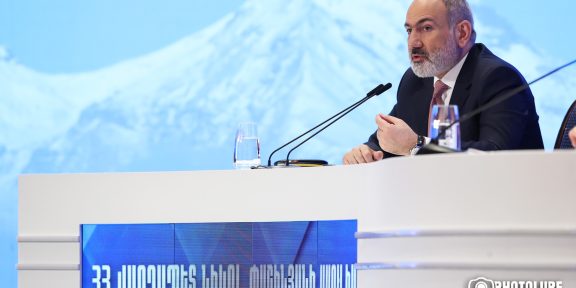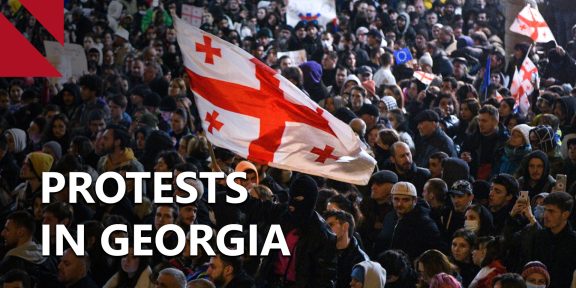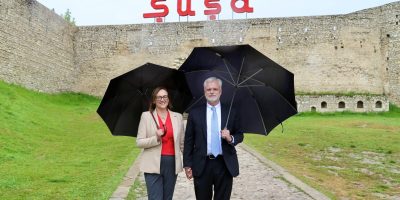 Nona Gabrielyan at the “Between Heaven & Earth” exhibition.
Nona Gabrielyan at the “Between Heaven & Earth” exhibition.
Nona Gabrielyan’s “BETWEEN HEAVEN & EARTH”
Nona Gabrielyan’s exhibition “Between Heaven & Earth” features a collection of paintings spanning 20 years. Gabrielyan is primarily a painter, but she also works with ceramics and writes poetry.
The title of the exhibition is apt, as many of Gabrielyan’s works are about in-between, spaces, the threshold between man and nature, light and shadow, imagination and reality, art and the audience. In “Dialogue” Gabrielyan shows the subtle space between man and nature, saying mankind belongs to nature; yet “dialogue” is a key term for many of her paintings.
 “Leder” Some paintings take Gabrielyan two to three hours to complete. Others, such as “Dialogue” two to three years. “Leder” took 20 minutes.
“Leder” Some paintings take Gabrielyan two to three hours to complete. Others, such as “Dialogue” two to three years. “Leder” took 20 minutes.
There is often a dialogue, not between two opposing forces, but between two entities that are deeply connected. It is as if there is a communion that allows for dialogue.
Visual art is an instrument, she said. She wants to show people the space between things. In “Light of the Shadow,” Gabrielyan tries to show that man can’t live without a shadow. But even the shadow has light, Gabrielyan says, but most people can’t see it.
Gabrielyan’s conceptions are almost metaphysical; they are about the realities beyond reality. In “Poems,” Gabrielyan sees two options. The woman becomes the poem that comes from beyond, or the woman gives the gift of poetry, which she has taken from the sky. She becomes, and she bestows.
Gabrielyan said her work is from the feeling of the moment, whether the art is abstract or more representational, or whether it is painting or ceramics or prose. It must come from the moment, and it must be honest.
“Honesty is the most important thing in art,” Gabrielyan said. “If you are not honest, it is not art.”In addition to Gabrielyan’s “Between Heaven and Earth” exhibition, the museum also features a collection of work by Gabrielyan’s German students entitled “Armenia In My Eyes.”
Both exhibitions will be on display until Wednesday, June 22.
Modern Art Museum of Yerevan: Permanent collection
Not only does the museum’s permanent collection include work by Nona Gabrielyan, but it also includes the work of her husband (Van Soghomonyan), daughter (Lilit Soghomonyan), and son-in-law (Gagik Ghazanchyan). Gabrielyan also pointed out the many works done by women in the museum collection to dispel the rumors that most museum art is created by men.
The Museum of Modern Art of Yerevan was the first modern art museum in the Soviet Union, established in 1972 by Henrik Igityan, who directed the museum for 37 years. Without financial assistance from the U.S.S.R., which discouraged work that deviated from the state-approved Socialist Realism, the museum found support from the 1960s Armenian and diaspora artists, many of whom donated work.
The work from many of these early artists form the foundation of the museum’s permanent collection, which has been growing ever since.
In addition to exhibiting visual art, the museum has also published several art books and catalogues under the direction of Henrik Igityan.
 “Volcanic Masses 2” (2012) by Raffi Tokatlian. Tokatlian, a sculptor and painter from Beirut
“Volcanic Masses 2” (2012) by Raffi Tokatlian. Tokatlian, a sculptor and painter from Beirut
 Foreground: “Requiem” (1984) by Nona Gabrielyan’s husband, Van Soghomonyan.
Foreground: “Requiem” (1984) by Nona Gabrielyan’s husband, Van Soghomonyan.
 “Funeral of my grandfather” (1951) by Hovhannes Semerjyan / Jean Jansem. In 2010, Semerjyan was awarded the Armenian Order of Glory for his contribution to the cultural ties between Armenia and France
“Funeral of my grandfather” (1951) by Hovhannes Semerjyan / Jean Jansem. In 2010, Semerjyan was awarded the Armenian Order of Glory for his contribution to the cultural ties between Armenia and France
What’s Next
Narine and Kiki Exhibition featuring art work by Narine Isajanyan and Grigor Mikaelyan opens at 6:00 PM on June 25.
Narine Isajanyan is an impressionist painter. She was born in Armenia and began drawing and painting at the age of five. Her work has been exhibited in Moscow, Beirut, Abu Dhabi, Croatia, Belgium, and Los Angeles.
Grigor Mikaelyan, also known as Kiki, is a Soviet-born American abstract artist influenced by Jackson Pollock. In addition to having work displayed in the Armenian Modern Art Museum, he also has work in state museums in Germany, Estonia, and Kazakhstan, as well as the Zimmerli Art Museum at Rutgers University, New Jersey. The Narine and Kiki Exhibition ends on July 2.
Photos and Text
Heather Momyer
Modern Art Museum of YerevanADDRESS: 7 Mesrop Mashtots Avenue
Yerevan, Armenia
HOURS: Tuesdays through Sundays: 11:00 AM to 6:00 PM
ADMISSION FEE: 500 drams, + an additional 500 drams to take photographs
WEBPAGE: http://www.mamy.am
FACEBOOK: https://www.facebook.com/Yerevan-Modern-Art-Museum-363107129500





















